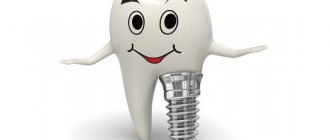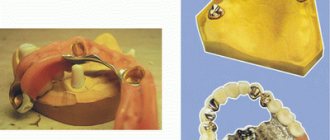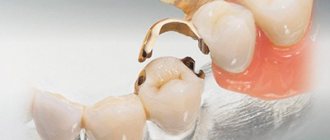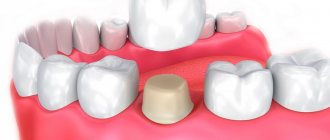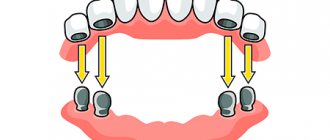Are you looking for a dentistry that will provide high-quality prosthetics for your upper teeth? The PRESIDENT complex offers its services! Experienced doctors, progressive techniques, reasonable prices - make an appointment by phone.
In orthopedic dentistry, one of the main tasks is prosthetics of the upper teeth. Their loss is not uncommon, especially when it comes to elderly patients. Restoring lost teeth is of great importance for a number of good reasons.
Why is missing teeth dangerous?
Losing a tooth is not just a cosmetic defect. It is capable of triggering irreversible changes in the human body that only progress over time.
If even one upper tooth is lost, its pair on the lower jaw is almost not involved in the process of chewing food. As a result, the adjacent teeth take on the load. The result is a violation of their ligamentous apparatus, due to which the risk of loss and periodontal development becomes extremely high.
The loss of several dental units increases the likelihood that the height of the bite will change. As a result, the lower third of the face becomes smaller. This not only leads to an aesthetic problem - the appearance of early wrinkles. Due to the unevenly distributed load, the temporomandibular joint suffers - inflammatory processes and degenerative changes begin.
The patient may experience pain while chewing food or talking. Improper chewing of food leads to diseases of the stomach and other gastrointestinal tract organs.
Methods of upper teeth prosthetics
Modern orthopedic dentistry uses many effective technologies for dental restoration. Various types of prostheses are used:
- bridge-like. They are a non-removable structure that is installed when 1-2 units of dentition are lost. They attach it to supporting units;
- removable plate. Inexpensive removable structures installed in place of lost teeth. They can be partial (restoring several units of the dentition) and complete (restoring the entire dentition);
- clasp (arc). They are a removable structure that uses a light metal arc. A durable, convenient solution that can restore chewing function well;
- conditionally removable. Can only be removed by a dentist. A system of locks (attachments) or a telescopic system without support from the sky can be used as fastening;
- crowns and bridges on implants. Today, the installation of implant systems is a priority method of prosthetics in European countries. Their installation is possible even with complete edentia.
The main difficulty when replacing defects in the lateral group is the proximity of the Maxillary sinus. It is extremely important that it be longer than the future implant. This is only possible if there is sufficient bone tissue. In some cases, a special operation is required in which bone tissue or a synthetic substrate is implanted.
Prosthetics for a completely toothless upper jaw
With complete edentia, it is possible to use various types of prostheses - plastic plates, lying on the oral mucosa, conditionally removable, which are fixed with implants.
Complete restoration from a functional and aesthetic point of view is possible if a minimum of four intraosseous implants are installed. The use of basal, mucosal implants is also considered acceptable, but such methods are not widespread.
Acrylic removable dentures are distinguished by their characteristics. The plate almost completely covers the hard palate. The valve area needs to be enlarged to improve fixation of the prosthesis. However, this method of prosthetics has a significant drawback - patients often note an increased gag reflex, as well as general discomfort.
However, it is worth noting that prosthetics for an edentulous upper jaw are simpler than for the lower jaw. This is due to the fact that the base of the prosthesis will not come into contact with the moving mucosa, thereby improving fixation and reducing discomfort when eating.
How are removable dentures made?
Prosthetics of the upper teeth using removable structures is a very common technique. It is carried out in several stages:
- inspection. At this stage, anamnesis is collected and a treatment plan is developed;
- taking impressions. For this, alginate material is used, as well as a standard dental instrument - a metal spoon;
- determination of jaw ratio. This is required so that the future prosthesis fits comfortably relative to the position of the jaw joint. Samples are carried out using an individual spoon;
- taking an impression. The spoon used during functional tests is used, and the doctor takes an impression. Based on it, a wax frame is made so that the patient can try it on;
- installation of a prosthesis. A prosthesis with a plastic base is placed in the oral cavity. After a few days of using it, correction is carried out.
PRESIDENT specialists have extensive experience in prosthetics of upper teeth. They will select the optimal type of prosthesis with which you will feel comfortable and can significantly improve your quality of life!
Prices
| Dental prosthetics | Price |
| Dental prosthetics using an implant: installation of a zirconium dioxide bridge supported by ASTRA-TECH implants (Sweden) | from 36,000 rub. |
| Prosthetics with partial removable plate dentures | from 28350 rub. |
| Prosthetics with partial removable lamellar dentures (immediate denture) | from 19600 rub. |
| Prosthetics with removable clasp dentures | from 49350 rub. |
| Dental prosthetics with complete removable plate dentures (immediate denture) | from 23,700 rub. |
| Dental prosthetics with complete removable plate dentures (immediate denture) in the area of the 1st tooth | from 15,000 rub. |
| Dental prosthetics with complete removable plate dentures (immediate denture) up to 3 teeth | from 12600 rub. |
| Restoring the integrity of the dentition with fixed bridges (tooth) | from 15500 rub. |
| Restoring the integrity of the dentition with fixed bridges (crown) | from 19350 rub. |
To avoid possible misunderstandings, please clarify the cost of services in clinics with the administrator or during a consultation with a doctor. Prices on the website are not a public offer.
Neutral zone" and "Valve zone" Methods of fixing and stabilizing prostheses.
Fixation is the strengthening of the prosthesis on the jaw when it is at rest and during auxiliary movements. The strength of fixation of the prosthesis depends on the anatomical conditions of the oral cavity, the type of mucous membrane and the method of obtaining an impression. Mechanical springs in the molar region, surgeon-on implants, physical magnets, cohesion weighting of the lower prosthesis. Biomechanical method-anatomical retention. It is created by natural formations: well-preserved alveolar ridges, pronounced arch of the palate on the upper part, tubercles on the lower part. Posidimolar and hyoid space on the lower part. As well as the use of gingival clasps and pelots (Kemeny suggested pelots for fixing the lower part, the cat combined with base with an elastic springy lever. The pelot is thrown through the internal oblique line and spreads on the s/o, which has a loose fabric connection in the underlayer). Physico-biological method: Its essence lies in the fact that the prostheses are fixed due to adhesion and functional suction. In the clinic, fixation is achieved due to: 1) the accuracy of the length of the edges of the prosthesis; 2) the volume of the edges; 3) some pressure of the edge of the prosthesis on the underlying tissues. On the upper part of the vestibular surface, the border of the prosthesis should cover the passively mobile mucous membrane, slightly squeezing it, contact the dome of the transitional fold (actively mobile mucous membrane) and have a concave vestibular surface. Along line A, the posterior edge of the prosthesis on the upper jaw should extend 1-2 mm onto the soft tissues, also squeezing them somewhat. On the lower part, dentures are made with reasonably expanded boundaries, covering, if possible, the retromolar and sublingual space, creating wings in the retroalveolar space. If it is not possible to achieve functional suction of the prosthesis, then expanding the boundaries is justified, since this reduces the pressure per unit area of the prosthetic bed, and it was previously mentioned that the mucous membrane of the lower jaw reacts to pressure with pain symptoms much faster than other things being equal mucous membrane of the upper jaw The neutral zone is the boundary between the mobile and immobile mucous membrane. This term was first coined by Traviss. The neutral zone is often called the transitional fold. It seems to us that the neutral zone runs slightly below the transitional fold, in the area of the so-called passively mobile mucous membrane. The term “valvular zone” refers to the contact of the edge of the prosthesis with the underlying tissues. When removing the prosthesis from the oral cavity, the valve zone does not exist, since this is not an anatomical formation, but a functional one.
Functional impressions.
Impressions, when the cat is received, take into account the changes in the relief actively - moving the s/r during functions, called functional. Based on the principle of pressure, they are divided into: 1. Compression - approx. on the lower part when the doctor diagnoses the presence of low subtact, thinned s/r. They allow obtain a relief of the base of the prosthesis, facilitating the transfer of chewing pressure to a large area of the bone base of the bed. Use low-flow, with a high degree of viscosity and plasticity of the mat. when you are young, press down the first layer, then remove the second layer.
BIOMECHANICS OF THE LOWER JAW
Biomechanics of the lower jaw. Biomechanics is the science of human and animal movements. It studies movement from the point of view of the laws of mechanics inherent in all mechanical movements of material bodies without exception. Biomechanics studies objective patterns, revealing: during research. Studying the movements of the lower jaw allows you to get an idea of their normality, as well as identify disorders and their manifestations in the functioning of muscles, joints, closure of teeth and periodontal condition. Chewing can be done normally only when the teeth are lower. and the upper jaws will come into contact (occlusion). The closure of the dentition is the main property of chewing movements. The human lower jaw moves in three directions: vertical (up and down), which corresponds to opening and closing. mouth, sagittal (forward and backward), transversal (right and left). Each movement of the lower jaw occurs with simultaneous sliding and rotation of the articular heads. The only difference is that in one case hinge movements predominate in the joints, and in the other - sliding ones. Vertical movements of the lower jaw. Vertical movements are made due to the alternating action of the muscles that lower the lower jaw. Lowering of the lower jaw occurs with active contraction of m. mylohyoideus, m. geniohyoideus and m. Digastricus, provided that the hyoid bone is fixed by the muscles lying below it. When closing the mouth, the lower jaw is raised by contracting m. temporalis, t. masseter and t. pterygoideus medialis with gradual relaxation of the muscles that lower the lower jaw. When opening the mouth simultaneously with the rotation of the lower jaw around an axis passing through the articular heads in the transverse direction, the articular heads slide down and forward along the slope of the articular tubercle. With maximum mouth opening, the articular heads are positioned at the anterior edge of the articular tubercle. In the upper section, the disc slides down and forward along with the articular head. In the lower one, the articular head rotates in the recess of the lower surface of the disc, which for it is a movable articular fossa. The distance between the upper and lower dentition in an adult at maximum opening is on average 4.4 cm. Sagittal movements of the lower jaw. Movement n/h forward is carried out. bilateral contraction lateral. Krylov muscles fixed in the fossae of the pterygoid processes and attached to the articular capsule and articular disc. The forward movement of the mandible can be divided into two phases. In the first phase, the disc, together with the head of the lower jaw, slides along the articular surface of the tubercles. In the second phase, the sliding of the head is accompanied by its articulated movement around its own transverse axis passing through the heads. Decree. movements are carried out simultaneously on the right and left. The greatest distance that the head can travel forward and down along the articular tubercle is 0.75-1 cm. When chewing, this distance is 2-3 mm. The distance that the articular head travels when the lower jaw moves forward is called the sagittal articular path. The sagittal articular path is characterized by a certain angle (Gysi angle = 33). It is formed by the intersection of a line lying along the continuation of the sagittal articular path with the occlusal (prosthetic) plane. - a plane that passes through the cutting edges of the first incisors of the lower jaw and the distal buccal cusps of wisdom teeth, and in their absence, through similar cusps of the second molars. Angle , under the cat the incisal point moves (sagittal incisal path) to the occl plane naz angle sag of the incisal path = 40-50. When the head is shifted to the side on the slave side, the head rotates around the vertical axis. On the balancer side it is shifted forward, down and inward, making a transverse articular path. The angle at which it has shifted is the angle of the transv sust path or Bennett = 17 (between the sar sust path and the transv sust path on the balance side). When the n/h is shifted to the right and left, the incisal point makes a lateral incisal path (Gothic angle=110) According to Gisi, chewing movements occur cyclically, in a “parallelogram”. The preservation of the cusp and incisal contacts is the most important factor in this theory, the authors of which believe that the inclination of the articular path gives direction to the movement of the mandible and that this movement is influenced by the size and shape of the articular cusp. According to the requirements of Gysi's theory, it is necessary: precise determination of the articular path; recording of the incisal path; determination of the sagittal compensation curve of the line;. determination of the transverse compensation curve of the line; taking into account the height of the cusps of the chewing teeth. From a whole series of articulation laws, Hanau identified 5 main factors, calling them the articulatory five: the inclination of the articular path; the severity of the compensation curve; inclination of the reference plane; inclination of the upper incisors; height of the mounds. Bonneville's laws: M / at the middle of the articular heads on each side and the point of contact of the cutting. the surface of the lower middle incisors is placed in a space of 10 cm, fluctuating only within the most insignificant limits; the same distance between the teeth and m / at both joints of the head. Thus, an equilateral triangle with a side of 10 cm is obtained. 2) the depth of the bite of the incisors is unproduced or random and depends on the apex of the cusps of the molar and premol. ., from the position of these teeth in the jaw arch and from the curvature of the entire dental arch. The height of the tubercles gradually decreases from premol. to articular. cusps. 3) incisors are the leaders of all movements of the lower part in the direction of the middle part, like the fangs of some living things. If the incisors of the middle part do not pass to the lower part of the incisors, then the molars and pre-cutters cannot have cusps; if there are bumps, then they will last more or less. The period of time is not used. 4) during chewing, when moving the lower part to the left, the outer and inner cusps of the molars of the left side are moved to the corresponding cusps of the upper part; at the same time, on the right side of the lower part of the body, the outer tubercles are moved to the inner part of the lower part of the body.
TEMPOROMANDibular joint Temporomandibular joint. Structure. Research methods. Relationships between the elements of the TMJ during movements. Sagittal, lateral (Bennett angle).
TMJ: provides articulation of the lower jaw with the temporal bone. Its anatomical features include incongruity, the presence of an articular disc not found in other human joints. -articular head n/h, articular fossa vis. bones, intra-articular disc, articular tubercle, articular capsule, bundles of the lateral pterygoid muscle, superior joint space, inferior joint space. The ligamentous apparatus is extra- and intracapsular. Shapes: flat, medium, steep Research methods: survey, palpation (manual diagnosis), CT, X-ray, audio, muscle electromyography, movement study (determination of discoordination). The lower jaw makes movements in three planes: vertical (alternate contraction of the levator and depressor muscles, lowering, contraction of the mylohyoid, digastric, hyoid-lingual with a fixed hyoid bone, lifting, contraction of the temporal, masticatory, pterygoid medial). The articular heads stand at the edge of the articular tubercle with the mouth maximally open. Sagittal forward movements bilateral contraction of the lateral pterygoid muscles in 2 phases. The sagittal articular path is the distance that the articular head passes when the jaw moves forward, characterized by the angle formed by the intersection of a line lying at the intersection lying on the continuation of the sagittal articular path. with occlusal (prosthetic plane) according to Gizi 33 degrees. Sagittal incisal 40-50 degrees. Lateral (transversal) as a result of unilateral contraction of the lateral pterygoid muscle. The articular head on one side rotates around an axis, and on the other side the head with the disc slides along the articular surface of the tubercle. Benet's angle - on the side of the contracted muscle, the articular head moves downward, forward, inward. Its path is at an angle to the sagittal line of the articular path (lateral angle) = 17 degrees. Transversal incisal angle 100-120 degrees.


